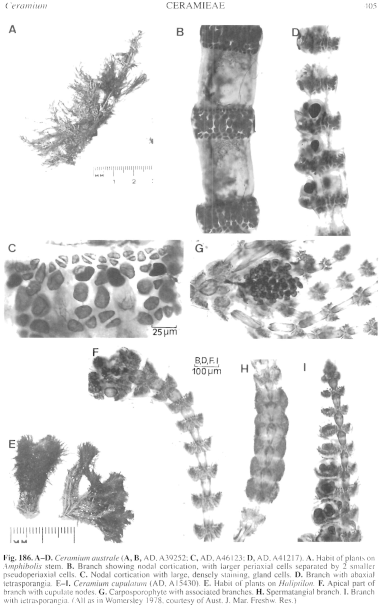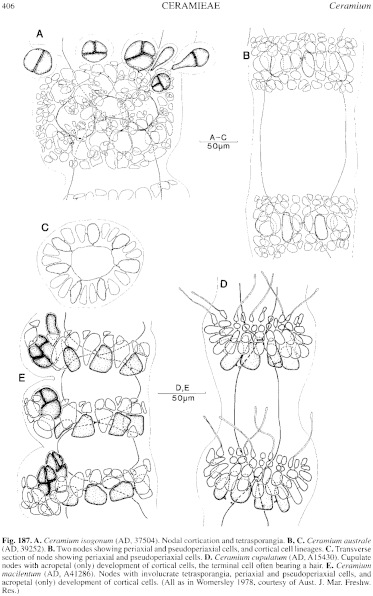|
|
|
|
|
|||||||||||
|
Electronic Flora of South Australia Species Fact Sheet
Phylum Rhodophyta – Order Ceramiales – Family Ceramiaceae – Tribe Ceramieae
Selected citations: J. Agardh 1851: 124; 1876: 93; 1894: 16. De Toni 1903: 1449. Harvey 1855a: 557; 1863, synop.: xlviii. Huisman et al. 1990: 96. Kendrick et al. 1990: 51. Silva et al. 1996: 390. Tisdall 1898: 503?. Womersley 1978: 230, figs 3B, C, 13A–D.
Synonyms
Gongroceras australe (Sonder) Kützing 1849: 679.
Episperma australis (Sonder) Kuntze 1891: 893.
Apona australis (Sonder) Kuntze 1898: 395.
Thallus (Fig. 186A) brown-red to dark red, 1–4 (–6) cm high, regularly subdichotomous in varied planes, without proliferous branchlets, with several erect branches arising from slight, prostrate, basal filaments. Attachment by uniseriate-celled rhizoids which may develop multicellular pads, arising from the periaxial (occasionally pseudoperiaxial) cells; epiphytic on seagrasses or red algae. Structure. Branches (160–) 200–300 µm in diameter below, decreasing gradually to 100–150 µm in diameter near the apices, then tapering more abruptly to the strongly involute apices. Axial cells isodiametric near apices, L/D (1–) 2–2.5 (–3) below, with regular, straight margined, bands of nodal cortication (Fig. 186B) mostly 80–120 µm long, separated by an internodal space 0.2–1 times the nodal length above and 2–3 times in the lower parts. Periaxial cells 6–7, each cutting off laterally (within the periaxial cell ring) two slightly smaller pseudoperiaxial cells (Figs 186C, 187B, C), each of which cuts off one cell acropetally and basipetally, these then dividing to form one or two cells which usually divide again, forming nodal cortication (5–) 7 cells long (Figs 186C, 187B); the true periaxial cells cut off one cell acropetally and this cuts off one or two more, but no cells are cut off basipetally (Fig. 187B); first acropetal derivative of the periaxial cells commonly cutting off a large gland like cell (Fig. 186C); no outer cortex is formed. Rhodoplasts discoid in small cells becoming ribbon like in larger cells.
Reproduction: Carposporophytes and spermatangia unknown
Tetrasporangia (Fig. 186D) produced in irregular abaxial series, with up to 3 per node formed successively, spreading around the node, cut off acropetally from periaxial cells, slightly basally involucrate by cortical filaments with slightly longer cells than in sterile nodes;
Type from W. Aust. (Preiss); probably from near Perth; type not located in MEL; lectotype in LD, 20679, on Haliptilon.
Selected specimens: Fremantle, W. Aust., (Harvey, Alg. Aust. Exsicc. 471A, in TCD). Tiparra Reef, Spencer Gulf, S. Aust, on Amphibolis griffithii, 11 m deep (Shepherd, 13.xii.1971; AD, A41217) and on A. antarctica, 5m deep (Shepherd, 13.vii.1971; AD, A39252). Aldinga, S. Aust., on Posidonia, 10 m deep (Johnson, 7.vii.1973; AD, A47993). Godfrey Is, Guichen Bay, S, Aust., on Posidonia australis, 2–3m deep (Shepherd, 15.ii.1975; AD, A46123). Walkerville, Vic., drift (Sinkora, A1572, 23.ii.1972; AD, A43146). Leven, Tas. (Lodder; MEL, 45454).
Distribution: Shark Bay, W. Aust., to Walkerville, Vic., and N Tasmania.
Taxonomic notes: tetrasporangia subspherical to pyriform, irregularly horizontally divided into bispores (in plants observed), 55–75 µm in diameter.
While superficially similar to C. isogonum, C. australe is distinctive in the pattern of nodal cortication. The lateral formation of pseudoperiaxial cells, which lie largely in the periaxial ring as seen in thallus section, thus giving a ring of 18 or 21 cells with the larger periaxial cells separated by two smaller pseudoperiaxial cells, is a pattern not seen in any other southern Australian species of Ceramium. Many of the first acropetal derivatives of the periaxial cells cut off a comparatively large and densely protoplasmic gland like cell.
The tetrasporangia as observed in the Tiparra specimens all appear to have only an irregularly horizontal division, though the sporangia appear mature; further observations on the sporangial division and release of spores are needed.
References:
AGARDH, J.G. (1851). Species Genera et Ordines Algarum. Vol. 2, Part 1, I-XII, 1–336 + index. (Gleerup: Lund.)
AGARDH, J.G. (1876). Species Genera et Ordines Algarum. Vol. 3, Part 1- Epicrisis systematic Floridearum, pp. i-vii, 1–724. (Weigel: Leipzig.)
DE TONI, G.B. (1903). Sylloge Algarum omnium hucusque Cognitarum. Vol. 4. Florideae. Sect. 3, pp. 775–1521 + 1523–1525. (Padua.)
HARVEY, W.H. (1855a). Some account of the marine botany of the colony of Western Australia. Trans. R. Jr. Acad. 22, 525–566.
HARVEY, W.H. (1863). Phycologia Australica. Vol. 5, Plates 241–300, synop., pp. i-lxxiii. (Reeve: London.)
HUISMAN, J.M., KENDRICK, G.A., WALKER, D.I. & COUTÉ, A. (1990). The Marine Algae of Shark Bay, Western Australia. Research in Shark Bay. Report of the France-Australe Bicentenary Expedition Committee, pp. 89–100.
KÜTZING, F.T. (1849). Species Algarum. (Leipzig.)
KENDRICK, G.A., HUISMAN, J.M. & WALKER, D.I. (1990). Benthic macroalgae of Shark Bay, Western Australia. Bot. Mar 33, 47–54.
KUNTZE, O. (1891). Revisio generum Plantarum. Part II. 4. Algae, pp. 877–930. (Leipzig.)
KUNTZE, O. (1898). Revisio generum Plantarum. Part III. 2. Algae, pp. 385–437. (Leipzig.)
SILVA, P.C., BASSON, P.W. & MOE, R.L. (1996). Catalogue of the Benthic Marine Algae of the Indian Ocean. (University of California Press: Berkeley, Los Angeles & London.)
SONDER, O.G. (1845). Nova Algarum genera et species, quas in itinere ad oras occidentales Novae Hollandiae, collegit L. Preiss, Ph.Dr. Bot. Zeit. 3, 49–57.
SONDER, O.W. (1848). Algae. In Lehmann, C., Plantae Preissianae. Vol. 2, pp. 161–195. (Hamburg.)
SONDER, O.W. (1881). In Mueller, F., Fragmenta Phytographiae Australiae. Supplementum ad volumen undecinum: Algae Australianae hactenus cognitae, pp. 1–42, 105–107. (Melbourne.)
TISDALL, H.T. (1898). The algae of Victoria. Rep. 7th Meet. Aust. Ass. Adv. Sci., Sydney, 1898, pp. 493–516.
WOMERSLEY, H.B.S. (1978). Southern Australian species of Ceramium Roth (Rhodophyta). Aust. J. Mar. Freshw. Res. 29, 205–257.
The Marine Benthic Flora of Southern Australia Part IIIC complete list of references.
Publication:
Womersley, H.B.S. (24 December, 1998)
The Marine Benthic Flora of Southern Australia
Rhodophyta. Part IIIC. Ceramiales – Ceramiaceae, Dasyaceae
©State Herbarium of South Australia, Government of South Australia
Illustrations in Womersley Part IIIA, 1998: FIGS 186 A–D, 187B, C.

Figure 186 enlarge
Fig. 186. A–D. Ceramium australe (A, B, AD, A39252; C, AD, A46123; D, AD, A41217). A. Habit of plants on Amphibolis stem. B. Branch showing nodal cortication, with larger periaxial cells separated by 2 smaller pseudoperiaxial cells. C. Nodal cortication with large, densely staining, gland cells. D. Branch with abaxial tetrasporangia. E–I. Ceramium cupulatum (AD, A 15430). E. Habit of plants on Haliptilon. F. Apical part of branch with cupulate nodes. G. Carposporophyte with associated branches. H. Spermatangial branch. I. Branch with tetrasporangia. (All as in Womersley 1978, courtesy of Aust. J. Mar. Freshw. Res.)

Figure 187 enlarge
Fig. 187. A. Ceramium isogonum (AD, 37504). Nodal cortication and tetrasporangia. B, C. Ceramium australe (AD, 39252). B. Two nodes showing periaxial and pseudoperiaxial cells, and cortical cell lineages. C. Transverse section of node showing periaxial and pseudoperiaxial cells. D. Ceramium cupulatum (AD, A15430). Cupulate nodes with acropetal (only) development of cortical cells, the terminal cell often bearing a hair. E. Ceramium macilentum (AD, A41286). Nodes with involucrate tetrasporangia, periaxial and pseudoperiaxial cells, and acropetal (only) development of cortical cells. (All as in Womersley 1978, courtesy of Aust. J. Mar. Freshw. Res.)

|
Email Contact: State Herbarium of South Australia |

|